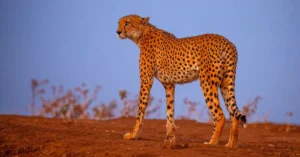
Where Do Cheetahs Live in the World: Exploring Different Types of Cheetah Habitats. Cheetahs are one of the most iconic and recognizable animals in the world. They are known for their incredible speed, agility, and grace, which make them highly effective hunters in their respective habitats. In this article, we will explore the different types of cheetah habitats, their adaptations to these environments, and the threats they face in the wild.
Exploring Different Types of Cheetah Habitats
Grasslands and Open Plains
Cheetahs are primarily found in grasslands and open plains, where they can use their speed and agility to chase prey. They prefer an environment with green vegetation, such as tall grass or bushes, to hide from predators. In Africa, they are most prevalent in countries such as Namibia, Botswana, Kenya, Tanzania and South Africa. In Asia, cheetahs are now found only in Iran, where the Asiatic cheetah subspecies is critically endangered.
Shrublands
Cheetahs are also tolerant of a wide range of habitats, including scrub. In this environment, they may use vegetation for cover while hunting. According to SeaWorld, cheetahs are tolerant of a wide range of habitats, including shrublands, grasslands, savannas, and temperate to hot deserts.
Deserts
Cheetahs are also found in deserts, where their speed and agility make them effective hunters. They are adapted to cope with the intense African sun and have a specialized respiratory and circulatory system that allows them to regulate their body temperature and cope with the heat in their habitat.
You are read Where Does Cheetah Live in the World? Exploring Different Types of Cheetah Habitats. also like you: Top 10 Fastest Land Mammal in the World
Woodlands
Although they are usually associated with open habitats, cheetahs can also be found in forested areas, where they may have to adapt their hunting strategies to suit dense vegetation. Cheetahs can live in a variety of habitats but prefer grasslands and open plains.
Adaptations to Different Types of Habitats
Cheetahs have developed a variety of physical and behavioral adaptations to these diverse habitats. Their speed and agility make them suitable for hunting in open grasslands and savannas, while their camouflage and hunting habits allow them to thrive in a variety of environments. Additionally, their unique social structures, including solitary living and small group living, have evolved to suit their specific ecological niche.
Their body shape and motion, camouflage, hunting habits, retractable claws, heat tolerance and agility are some of the physical adaptations that enable them to survive in different habitats. These adaptations have evolved to suit their specific ecological niche, making them highly specialized and successful predators in their respective environments.
You are read Where Does Cheetah Live in the World? Exploring Different Types of Cheetah Habitats. also like you: what is the fastest land animal in the world Top 10 fastest land animals?
what are the benefits of cheetahs living in different types of habitats
Cheetahs living in different types of habitats offer several benefits to both the species and the ecosystem. Some of these benefits include:
cheetahs living in different types of habitats offers several benefits to both the species and the ecosystem. These benefits include resource availability, predator protection, sharing resources and caretaking, maintaining healthy prey populations, controlling herbivore populations, and preventing overgrazing. By inhabiting diverse habitats, cheetahs play a crucial role in maintaining balanced and healthy ecosystems, which in turn contributes to their survival and the preservation of their habitats.
Threats to Cheetah Habitats
Human-wildlife conflict is a major threat to cheetahs. As their habitat and available natural prey decrease, cheetahs face conflict with farmers. Cheetahs are more likely to attack livestock, resulting in farmers killing them in retaliation. Habitat loss is another major threat to the cheetah, as human activity expands into the cheetah’s habitat. Cheetahs require large areas of connected habitat to survive, as cat densities are low throughout its range. Illegal wildlife trade and the exotic pet trade are other major threats to the species. Cheetahs are often hunted for their skins.
You are read Where Does Cheetah Live in the World? Exploring Different Types of Cheetah Habitats. also like you: 10 Most Handsome Eagles in the World: A Majestic Display of Nature’s Beauty
Conservation Efforts
Conservation groups are working to protect the species. Wildlife parks in Africa help protect some cheetahs as their habitat shrinks. The African Wildlife Foundation (AWF) is helping cheetahs by working with local communities to reduce human-cheetah conflicts by helping farmers protect their livestock. Cheetah Conservation Fund (CCF) is another organization working to protect cheetahs and their habitat. They work with local communities to promote coexistence between humans and cheetahs, and they conduct research to better understand the species and its needs.
Conclusion
cheetahs are highly adaptable predators, capable of thriving in a variety of habitats, including grasslands, savannahs, shrublands, deserts, and woodlands. Their physical and behavioral adaptations have evolved to suit these diverse environments, making them highly specialized and successful predators in their respective habitats. However, their habitats are being threatened by human expansion, which has led to habitat destruction and fragmentation. The loss of their habitat is a significant threat to the cheetah population, and conservation efforts are essential to protect these iconic animals and their ecosystems.


